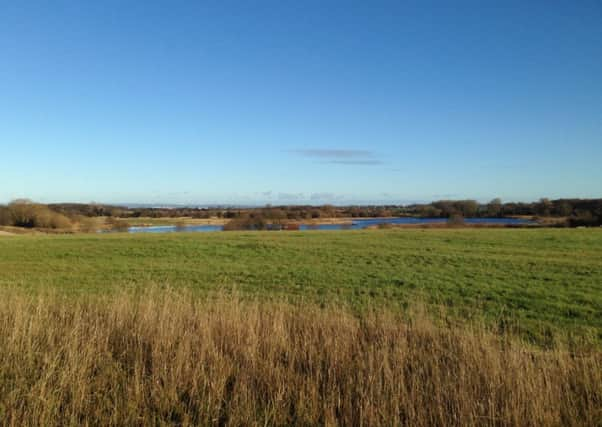Otters, birds and deer at a thriving nature reserve


Otters are regularly spotted on the 79-hectare site, which is owned and managed by the Yorkshire Wildlife Trust (YWT), and, during the winter months, it’s home to vast flocks of wildfowl, including widgeon, teal and geese. Located just a couple of miles off junction 48 of the A1, the reserve comprises two lagoons, countless ponds and a wildlife-friendly combination of fen, reed beds, woodland and grassland.
The River Tutt flows along the site’s northern boundary, and from the central viewing point you can admire the fantastic vista out across the largest lagoon and towards the North York Moors beyond. The famous white horse carved into the hillside above the village of Kilburn, which is 20 miles away, is clearly visible in the distance.
Advertisement
Hide AdAdvertisement
Hide AdIt’s an area of North Yorkshire that has long been renowned for its plant life. In the 18th century the Reverend James Dalton recorded rare woodland and marshland plants here, which formed part of the ‘Herbarium of the Yorkshire Philosophical Society’. However, during the 1970s and 1980s, Staveley Carrs, as the reserve was previously known, was reshaped by years of sand and gravel quarrying.
Astonishingly, as the YWT’s northern reserves manager Dr Jenny Haywood explained, the wealth of plant life somehow survived the years of heavy industry. During the summer months, the grassland is littered with wildflowers, including scarce species such as marsh helleborines, water violets and bee orchids.
“Some of the land was backfilled and other areas left to re-colonise. This is the only place where a fen meadow has reformed naturally but this land was part of a large valley down to the A1 that was well known for plant life, so a seed bank must have been present here.
“Some areas are already very well established, whereas other areas were still arable fields just five years ago. As well as the rarer species of plant life, this site is great for cowslips in the spring and early summer.”
Advertisement
Hide AdAdvertisement
Hide AdAccording to Jenny, there’s plenty to see all year round, including more than 200 different species of birds, 22 species of dragonflies and damselflies, and mammals including badgers, deer, fox, water shrew and harvest mice.
“During the winter, you can see hundreds of yellow hammers and there are currently large numbers of teal, plus we have nesting barn owls. My closest experience ever with a barn owl happened here; it flew directly at me just a metre above my head. It was just having a look at me I think.”
Jenny points out a mound of earth, which is, in fact, a kind of artificial wall created for sand martins to nest in. It was only built last year, but was used as a nesting site this summer.
“We have to fumigate it each year to get rid of parasites or the birds wouldn’t want to use it again,” says Jenny.
Advertisement
Hide AdAdvertisement
Hide AdLapwings also nested at the site for the first time this year on an area where traditional ridge and furrow ploughing techniques have been used to create wetland. Islands have been formed in the lagoons for breeding ringed plover and oyster catchers, as well as the avocets that visit the site.
As part of the reserve’s management, small herds of Hebridean sheep, and Highland and White Park cattle graze the grassland to create the perfect mix of tussocks, shorter grass and muddy areas that are so important for wading birds. The livestock is cared for by the YWT’s stock team, but the local volunteers who help to run the site also keep an eye on them. It’s just one of many tasks that people give up their spare time to assist with.
On the day I visited a number of volunteers were baking potatoes on a bonfire by the West Lagoon as part of an al fresco festive celebration.
Volunteer co-ordinators Racheal Green and Andrew Dodd, both of whom live in nearby Harrogate, organise the annual get together to thank the team for their work. Both volunteers themselves, they’ve been trained to lead groups of people doing voluntary work on the reserve, which, as Rachael explained, saves members of the YWT’s team from having to be present.
Advertisement
Hide AdAdvertisement
Hide Ad“Four years ago I was made redundant and I wanted to do something completely different,” she said. “I love the outdoors so I started volunteering here. I’m now working again and I actually book days off to come and volunteer here because I love it so much.”
Andrew said: “I started four years ago too, and it’s good to be out on the reserve. You tend to get a mix of early retired people, like me; students looking for work experience that will help them get a job in conservation; and then on Saturdays there are opportunities for people who work during the week.”
Volunteers help with everything from monitoring water levels to recording butterfly species they spot.
A Heritage Lottery Fund grant enabled the YWT to extend the reserve in 2010. Two years ago children from Staveley Community Primary School helped to plant around 100 fruit trees on the site and, in 2015, the school will be involved in planting wildflower plug plants in the orchard area.